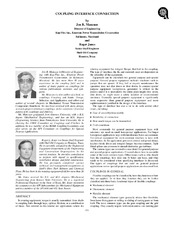| dc.description.abstract | In rotating equipment, torque is usually transmitted from shafts to coupling hubs through keys, splines, friction, or a combination of these. Not covered in this tutorial are applications where the rotating equipment has integral flanges that bolt to the coupling. The type of interface, the fit, and materials used are dependent on the criticality of the equipment. Equipment can be classified into general purpose and special purpose. General purpose equipment includes machines such as pumps that are spared. If they fail or require maintenance the operation does not shut down or slow down. In contrast special purpose equipment (compressor, generator) is critical to the process and if it is unavailable the entire plant might slow down, shut down, or might incur a safety incident or environmental incidence. Generally special purpose equipment and more sophistication is justified in the design of the interface. The type of interface has also a lot to do with several other issues, including:
• Ease of assembly/disassembly
• Reliability of connection
• How much torque can be transmitted
• Field conditions
Most commonly for general purpose equipment keys with setscrews are used on a small horsepower applications. For larger horsepower applications keys with interference bores are common. For critical equipment the most common interface is keys with interference. As the application gets more critical and power dense, keyless shrink drives and integral flanges become common. Tight fitted splines are common in aircraft derivative gas turbines. The various types are covered in some detail for general purpose and special purpose applications. Covered also is how to assemble some of the most common types. Other issues such as who should bore the couplings, how does one fit bores and keys, and what needs to be considered when specifying interfaces is discussed. They types of couplings that are used on general purpose applications versus special purpose applications are discussed first. | en |


